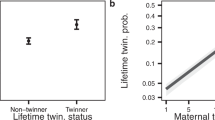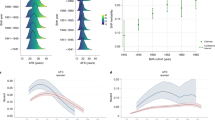Abstract
MAXIMUM reproductivity in a monogamous society requires that males and females of appropriate age shall be available in approximately equal numbers. A considerable excess of one sex or the other will decrease the reproduction-rate. In practice, there rarely seems to be an excess of males of this age; among European races a slight excess of females is usual.War, or other events involving a differential toll of men of reproductive age, naturally exaggerate the excess of females. In England and Wales before the War of 1914–181, there was an excess of some 649,000 or 8·7 per cent of females over males, at ages 20—45 years. For several years after 1918 the excess was more than a million, being about 1,050,000, or 13·4 per cent in 19252. Ten years later, in 19353, the effects of the war were disappearing and the excess of females was down to 658,000, or 7·9 per cent, but it may well increase again considerably as a result of the present War. The surplus women, on statistical grounds alone, are evidently unable to get married in Great Britain, and the great majority of them, therefore, are sociologically sterilized. The number represents an appreciable percentage of the females of reproductive age, and this sociological sterility is a not inconsiderable factor in birth-rate problems. Groome4 calculated that an increase in the net reproduction-rate of some 15 per cent would be expected to result from equalizing the numbers of males and females of reproductive age, even without any increase in the total population.
This is a preview of subscription content, access via your institution
Access options
Subscribe to this journal
Receive 51 print issues and online access
$199.00 per year
only $3.90 per issue
Buy this article
- Purchase on Springer Link
- Instant access to full article PDF
Prices may be subject to local taxes which are calculated during checkout
Similar content being viewed by others
References
Registrar General's Statistical Review, 1913.
Registrar General's Statistical Review, 1925.
Registrar General's Statistical Review, 1935.
Groome, J. R., Eug. Rev., 29, 154 (1937).
Russell, W. T., J. Hygiene, 36, 381 (1936).
Martin, W. J., Lancet, 245, 807 (Dec. 25, 1943).
Parkes, A. S., Biol. Rev., 2, 1 (1926).
Auerbach, E., Arch. f. Rassen. und Gesellschafts Biol., 9, 10 (1912).
Tschuprow, Al. A., Bull. Inst. Int. Stat., 20, 378 (1915).
Parkes, A. S., J. Genetics, 14, 39 (1924).
Author information
Authors and Affiliations
Rights and permissions
About this article
Cite this article
PARKES, A. Prenatal Mortality and the Birth-Rate. Nature 153, 245–246 (1944). https://doi.org/10.1038/153245a0
Issue Date:
DOI: https://doi.org/10.1038/153245a0
This article is cited by
-
Prenatal Mortality
Nature (1944)
Comments
By submitting a comment you agree to abide by our Terms and Community Guidelines. If you find something abusive or that does not comply with our terms or guidelines please flag it as inappropriate.



